Leadership Style of Jawaharlal Nehru
VerifiedAdded on 2022/08/12
|12
|2393
|205
AI Summary
In this assignment, their is required leadership exemplar and i have chosen my leadership exemplar is Pandit Jawaharlal Nehru.
Contribute Materials
Your contribution can guide someone’s learning journey. Share your
documents today.
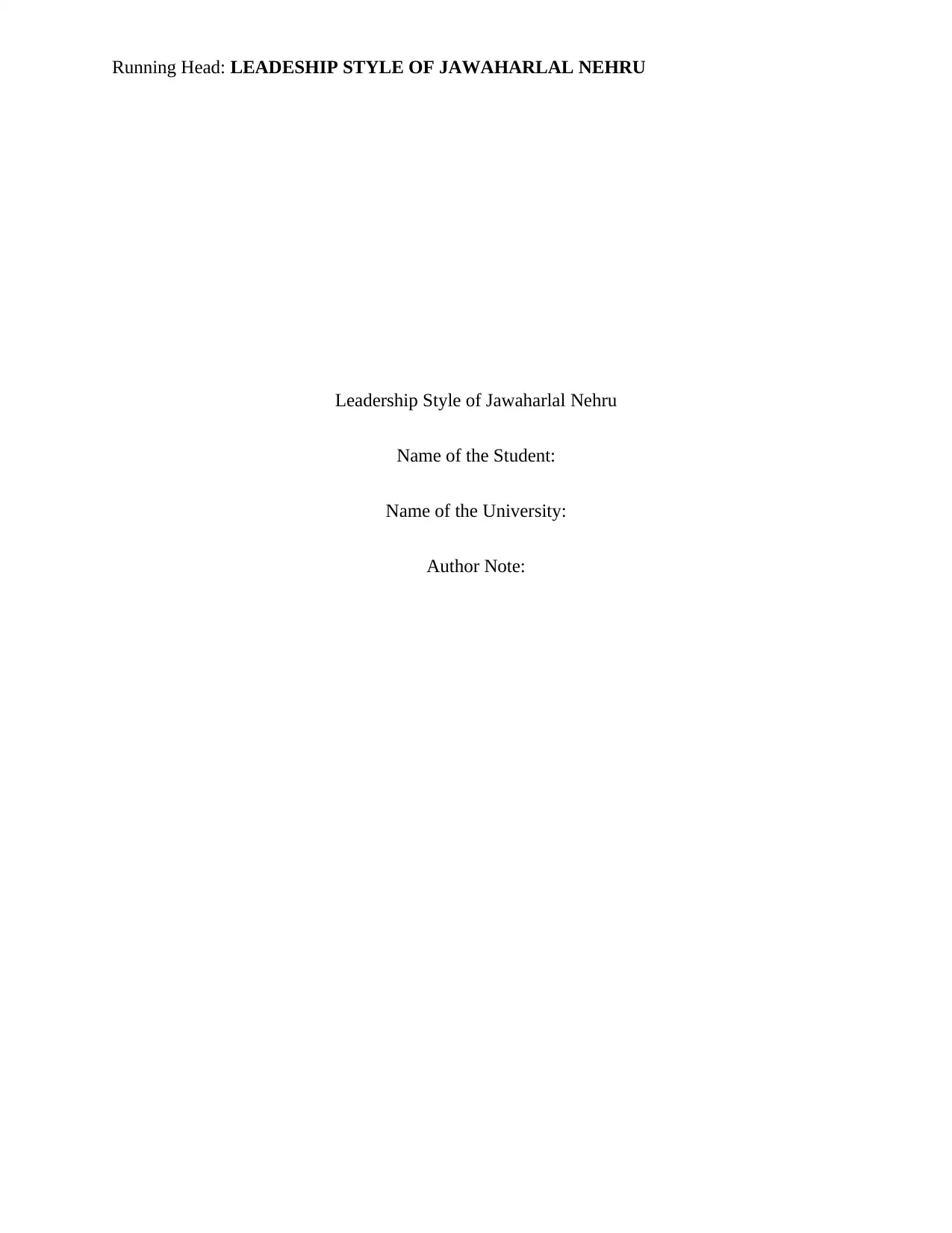
Running Head: LEADESHIP STYLE OF JAWAHARLAL NEHRU
Leadership Style of Jawaharlal Nehru
Name of the Student:
Name of the University:
Author Note:
Leadership Style of Jawaharlal Nehru
Name of the Student:
Name of the University:
Author Note:
Secure Best Marks with AI Grader
Need help grading? Try our AI Grader for instant feedback on your assignments.
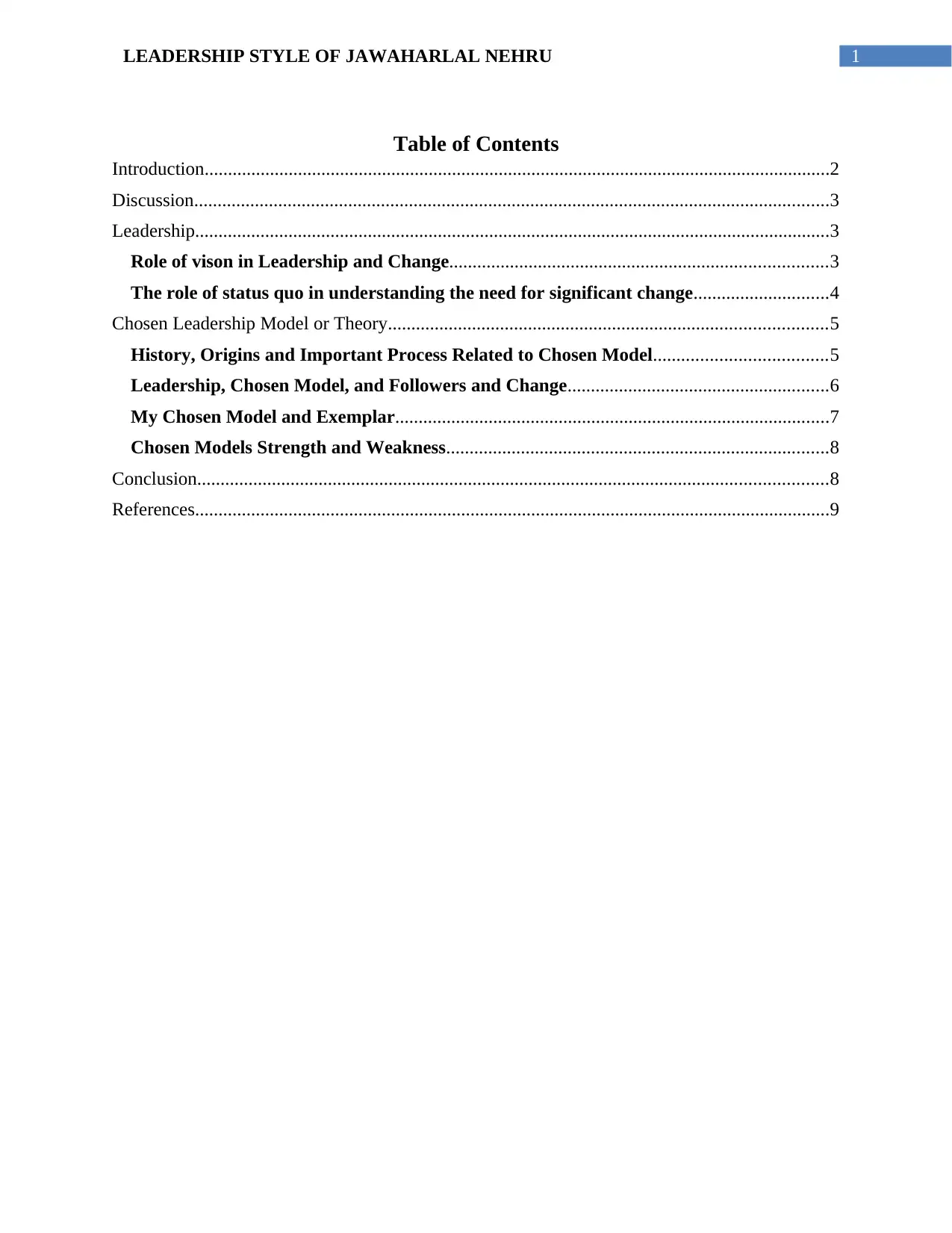
1LEADERSHIP STYLE OF JAWAHARLAL NEHRU
Table of Contents
Introduction......................................................................................................................................2
Discussion........................................................................................................................................3
Leadership........................................................................................................................................3
Role of vison in Leadership and Change.................................................................................3
The role of status quo in understanding the need for significant change.............................4
Chosen Leadership Model or Theory..............................................................................................5
History, Origins and Important Process Related to Chosen Model.....................................5
Leadership, Chosen Model, and Followers and Change........................................................6
My Chosen Model and Exemplar.............................................................................................7
Chosen Models Strength and Weakness..................................................................................8
Conclusion.......................................................................................................................................8
References........................................................................................................................................9
Table of Contents
Introduction......................................................................................................................................2
Discussion........................................................................................................................................3
Leadership........................................................................................................................................3
Role of vison in Leadership and Change.................................................................................3
The role of status quo in understanding the need for significant change.............................4
Chosen Leadership Model or Theory..............................................................................................5
History, Origins and Important Process Related to Chosen Model.....................................5
Leadership, Chosen Model, and Followers and Change........................................................6
My Chosen Model and Exemplar.............................................................................................7
Chosen Models Strength and Weakness..................................................................................8
Conclusion.......................................................................................................................................8
References........................................................................................................................................9
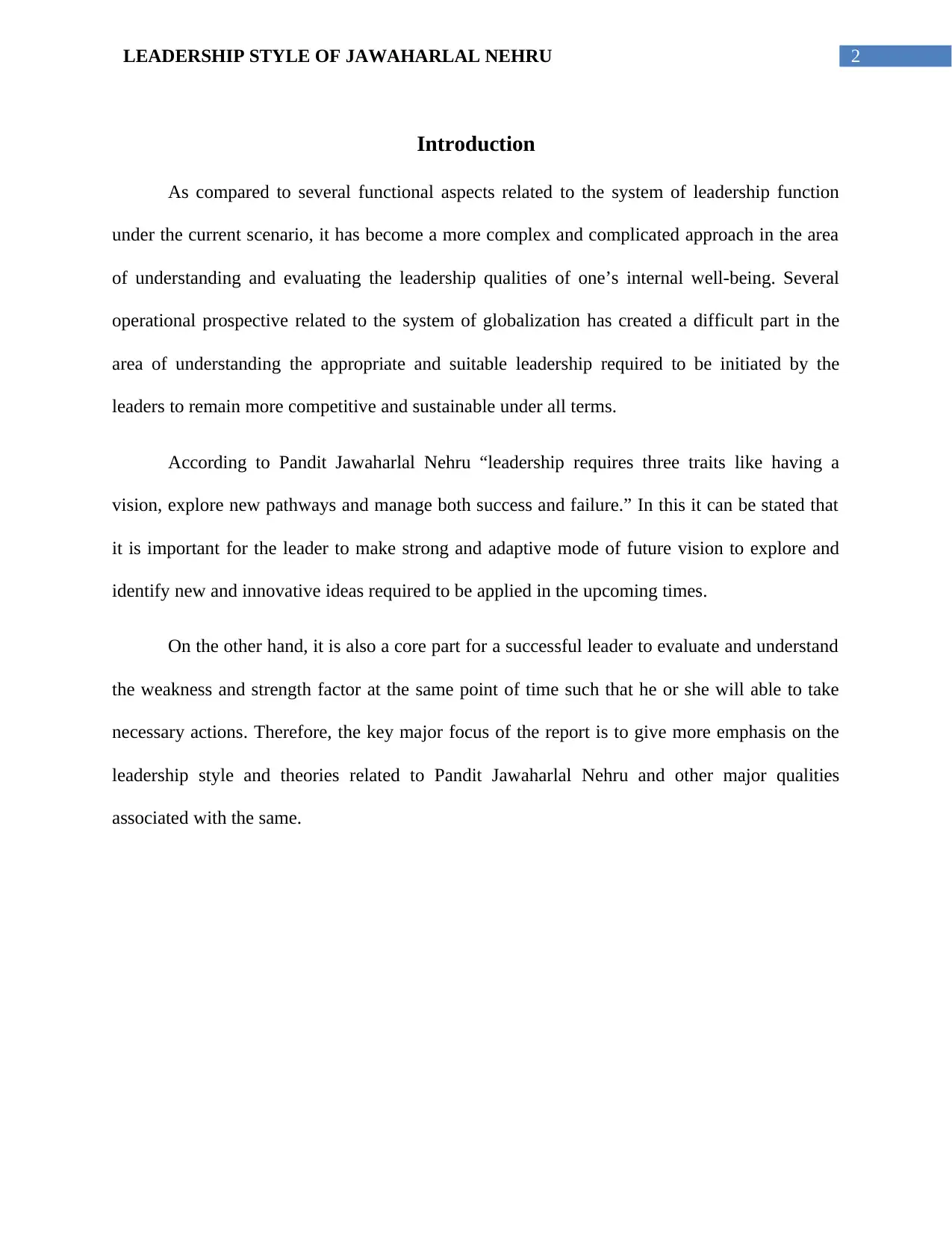
2LEADERSHIP STYLE OF JAWAHARLAL NEHRU
Introduction
As compared to several functional aspects related to the system of leadership function
under the current scenario, it has become a more complex and complicated approach in the area
of understanding and evaluating the leadership qualities of one’s internal well-being. Several
operational prospective related to the system of globalization has created a difficult part in the
area of understanding the appropriate and suitable leadership required to be initiated by the
leaders to remain more competitive and sustainable under all terms.
According to Pandit Jawaharlal Nehru “leadership requires three traits like having a
vision, explore new pathways and manage both success and failure.” In this it can be stated that
it is important for the leader to make strong and adaptive mode of future vision to explore and
identify new and innovative ideas required to be applied in the upcoming times.
On the other hand, it is also a core part for a successful leader to evaluate and understand
the weakness and strength factor at the same point of time such that he or she will able to take
necessary actions. Therefore, the key major focus of the report is to give more emphasis on the
leadership style and theories related to Pandit Jawaharlal Nehru and other major qualities
associated with the same.
Introduction
As compared to several functional aspects related to the system of leadership function
under the current scenario, it has become a more complex and complicated approach in the area
of understanding and evaluating the leadership qualities of one’s internal well-being. Several
operational prospective related to the system of globalization has created a difficult part in the
area of understanding the appropriate and suitable leadership required to be initiated by the
leaders to remain more competitive and sustainable under all terms.
According to Pandit Jawaharlal Nehru “leadership requires three traits like having a
vision, explore new pathways and manage both success and failure.” In this it can be stated that
it is important for the leader to make strong and adaptive mode of future vision to explore and
identify new and innovative ideas required to be applied in the upcoming times.
On the other hand, it is also a core part for a successful leader to evaluate and understand
the weakness and strength factor at the same point of time such that he or she will able to take
necessary actions. Therefore, the key major focus of the report is to give more emphasis on the
leadership style and theories related to Pandit Jawaharlal Nehru and other major qualities
associated with the same.
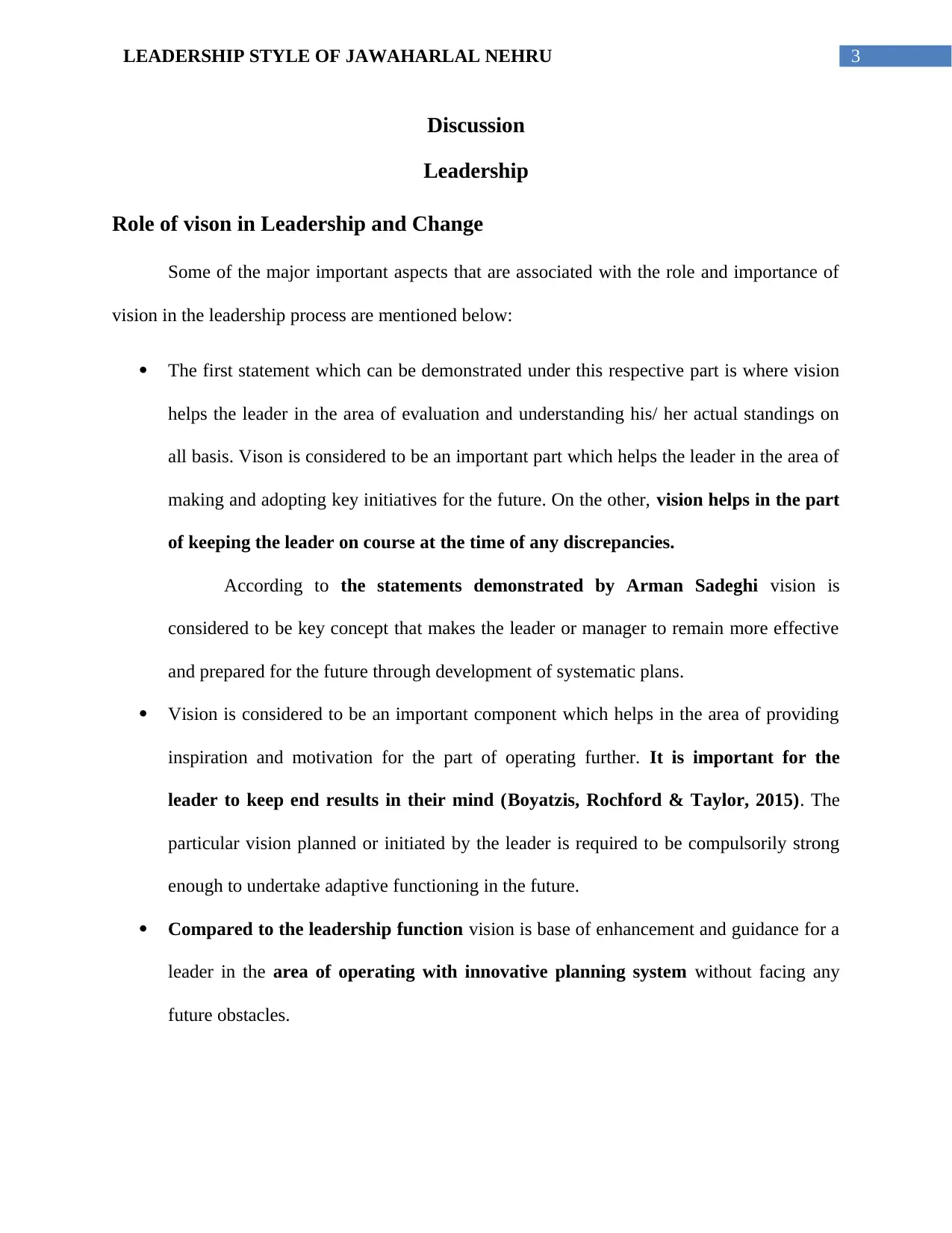
3LEADERSHIP STYLE OF JAWAHARLAL NEHRU
Discussion
Leadership
Role of vison in Leadership and Change
Some of the major important aspects that are associated with the role and importance of
vision in the leadership process are mentioned below:
The first statement which can be demonstrated under this respective part is where vision
helps the leader in the area of evaluation and understanding his/ her actual standings on
all basis. Vison is considered to be an important part which helps the leader in the area of
making and adopting key initiatives for the future. On the other, vision helps in the part
of keeping the leader on course at the time of any discrepancies.
According to the statements demonstrated by Arman Sadeghi vision is
considered to be key concept that makes the leader or manager to remain more effective
and prepared for the future through development of systematic plans.
Vision is considered to be an important component which helps in the area of providing
inspiration and motivation for the part of operating further. It is important for the
leader to keep end results in their mind (Boyatzis, Rochford & Taylor, 2015). The
particular vision planned or initiated by the leader is required to be compulsorily strong
enough to undertake adaptive functioning in the future.
Compared to the leadership function vision is base of enhancement and guidance for a
leader in the area of operating with innovative planning system without facing any
future obstacles.
Discussion
Leadership
Role of vison in Leadership and Change
Some of the major important aspects that are associated with the role and importance of
vision in the leadership process are mentioned below:
The first statement which can be demonstrated under this respective part is where vision
helps the leader in the area of evaluation and understanding his/ her actual standings on
all basis. Vison is considered to be an important part which helps the leader in the area of
making and adopting key initiatives for the future. On the other, vision helps in the part
of keeping the leader on course at the time of any discrepancies.
According to the statements demonstrated by Arman Sadeghi vision is
considered to be key concept that makes the leader or manager to remain more effective
and prepared for the future through development of systematic plans.
Vision is considered to be an important component which helps in the area of providing
inspiration and motivation for the part of operating further. It is important for the
leader to keep end results in their mind (Boyatzis, Rochford & Taylor, 2015). The
particular vision planned or initiated by the leader is required to be compulsorily strong
enough to undertake adaptive functioning in the future.
Compared to the leadership function vision is base of enhancement and guidance for a
leader in the area of operating with innovative planning system without facing any
future obstacles.
Secure Best Marks with AI Grader
Need help grading? Try our AI Grader for instant feedback on your assignments.
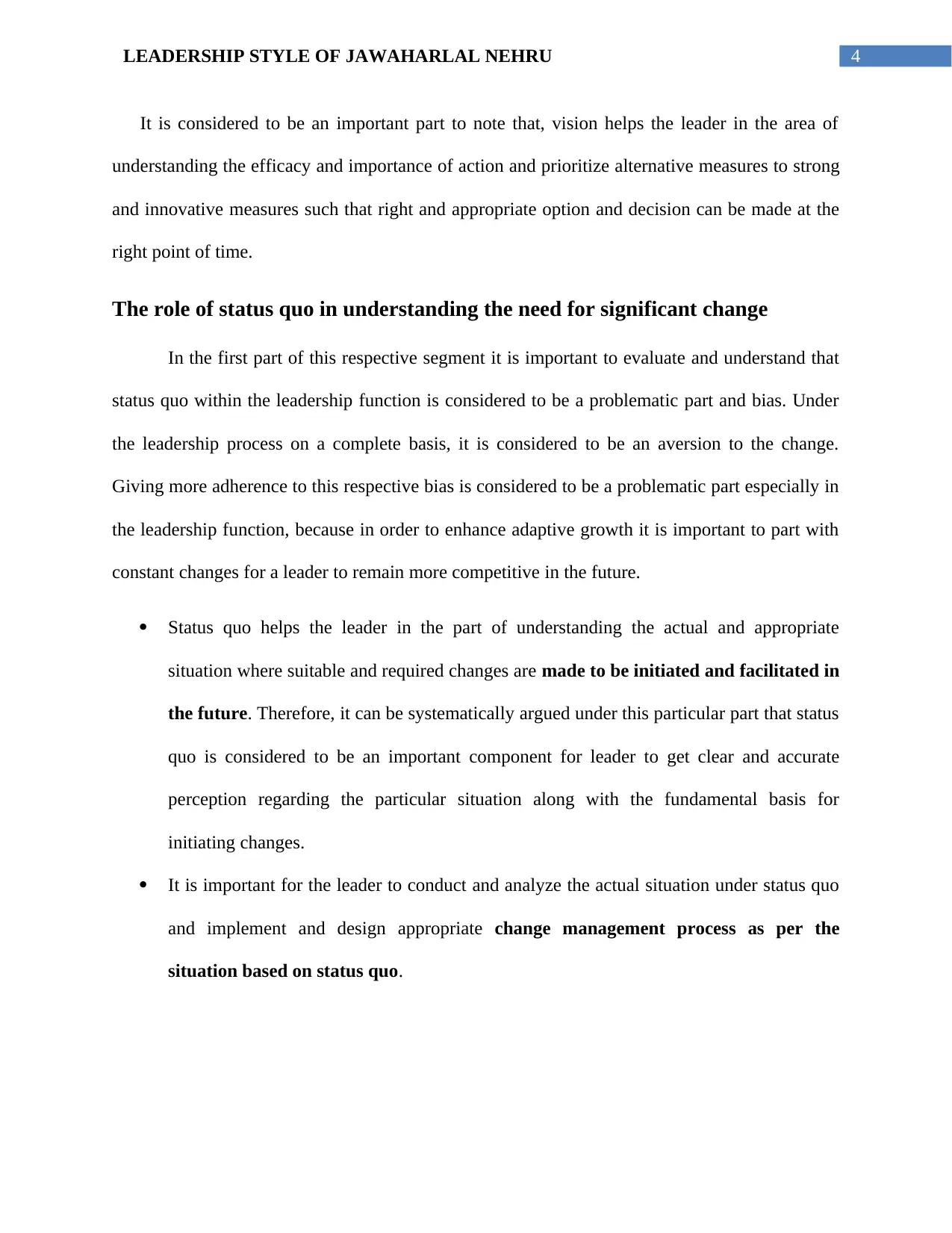
4LEADERSHIP STYLE OF JAWAHARLAL NEHRU
It is considered to be an important part to note that, vision helps the leader in the area of
understanding the efficacy and importance of action and prioritize alternative measures to strong
and innovative measures such that right and appropriate option and decision can be made at the
right point of time.
The role of status quo in understanding the need for significant change
In the first part of this respective segment it is important to evaluate and understand that
status quo within the leadership function is considered to be a problematic part and bias. Under
the leadership process on a complete basis, it is considered to be an aversion to the change.
Giving more adherence to this respective bias is considered to be a problematic part especially in
the leadership function, because in order to enhance adaptive growth it is important to part with
constant changes for a leader to remain more competitive in the future.
Status quo helps the leader in the part of understanding the actual and appropriate
situation where suitable and required changes are made to be initiated and facilitated in
the future. Therefore, it can be systematically argued under this particular part that status
quo is considered to be an important component for leader to get clear and accurate
perception regarding the particular situation along with the fundamental basis for
initiating changes.
It is important for the leader to conduct and analyze the actual situation under status quo
and implement and design appropriate change management process as per the
situation based on status quo.
It is considered to be an important part to note that, vision helps the leader in the area of
understanding the efficacy and importance of action and prioritize alternative measures to strong
and innovative measures such that right and appropriate option and decision can be made at the
right point of time.
The role of status quo in understanding the need for significant change
In the first part of this respective segment it is important to evaluate and understand that
status quo within the leadership function is considered to be a problematic part and bias. Under
the leadership process on a complete basis, it is considered to be an aversion to the change.
Giving more adherence to this respective bias is considered to be a problematic part especially in
the leadership function, because in order to enhance adaptive growth it is important to part with
constant changes for a leader to remain more competitive in the future.
Status quo helps the leader in the part of understanding the actual and appropriate
situation where suitable and required changes are made to be initiated and facilitated in
the future. Therefore, it can be systematically argued under this particular part that status
quo is considered to be an important component for leader to get clear and accurate
perception regarding the particular situation along with the fundamental basis for
initiating changes.
It is important for the leader to conduct and analyze the actual situation under status quo
and implement and design appropriate change management process as per the
situation based on status quo.
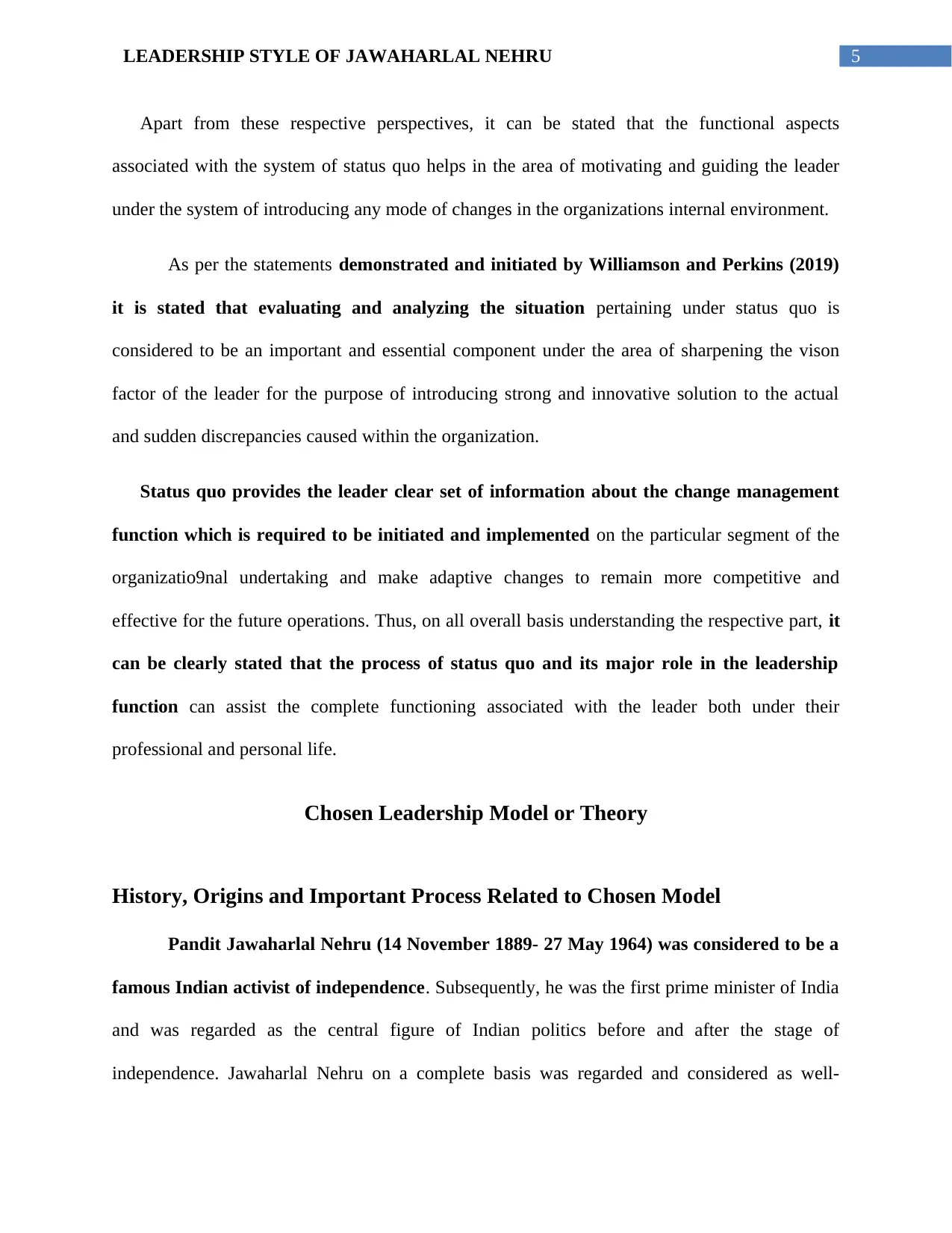
5LEADERSHIP STYLE OF JAWAHARLAL NEHRU
Apart from these respective perspectives, it can be stated that the functional aspects
associated with the system of status quo helps in the area of motivating and guiding the leader
under the system of introducing any mode of changes in the organizations internal environment.
As per the statements demonstrated and initiated by Williamson and Perkins (2019)
it is stated that evaluating and analyzing the situation pertaining under status quo is
considered to be an important and essential component under the area of sharpening the vison
factor of the leader for the purpose of introducing strong and innovative solution to the actual
and sudden discrepancies caused within the organization.
Status quo provides the leader clear set of information about the change management
function which is required to be initiated and implemented on the particular segment of the
organizatio9nal undertaking and make adaptive changes to remain more competitive and
effective for the future operations. Thus, on all overall basis understanding the respective part, it
can be clearly stated that the process of status quo and its major role in the leadership
function can assist the complete functioning associated with the leader both under their
professional and personal life.
Chosen Leadership Model or Theory
History, Origins and Important Process Related to Chosen Model
Pandit Jawaharlal Nehru (14 November 1889- 27 May 1964) was considered to be a
famous Indian activist of independence. Subsequently, he was the first prime minister of India
and was regarded as the central figure of Indian politics before and after the stage of
independence. Jawaharlal Nehru on a complete basis was regarded and considered as well-
Apart from these respective perspectives, it can be stated that the functional aspects
associated with the system of status quo helps in the area of motivating and guiding the leader
under the system of introducing any mode of changes in the organizations internal environment.
As per the statements demonstrated and initiated by Williamson and Perkins (2019)
it is stated that evaluating and analyzing the situation pertaining under status quo is
considered to be an important and essential component under the area of sharpening the vison
factor of the leader for the purpose of introducing strong and innovative solution to the actual
and sudden discrepancies caused within the organization.
Status quo provides the leader clear set of information about the change management
function which is required to be initiated and implemented on the particular segment of the
organizatio9nal undertaking and make adaptive changes to remain more competitive and
effective for the future operations. Thus, on all overall basis understanding the respective part, it
can be clearly stated that the process of status quo and its major role in the leadership
function can assist the complete functioning associated with the leader both under their
professional and personal life.
Chosen Leadership Model or Theory
History, Origins and Important Process Related to Chosen Model
Pandit Jawaharlal Nehru (14 November 1889- 27 May 1964) was considered to be a
famous Indian activist of independence. Subsequently, he was the first prime minister of India
and was regarded as the central figure of Indian politics before and after the stage of
independence. Jawaharlal Nehru on a complete basis was regarded and considered as well-
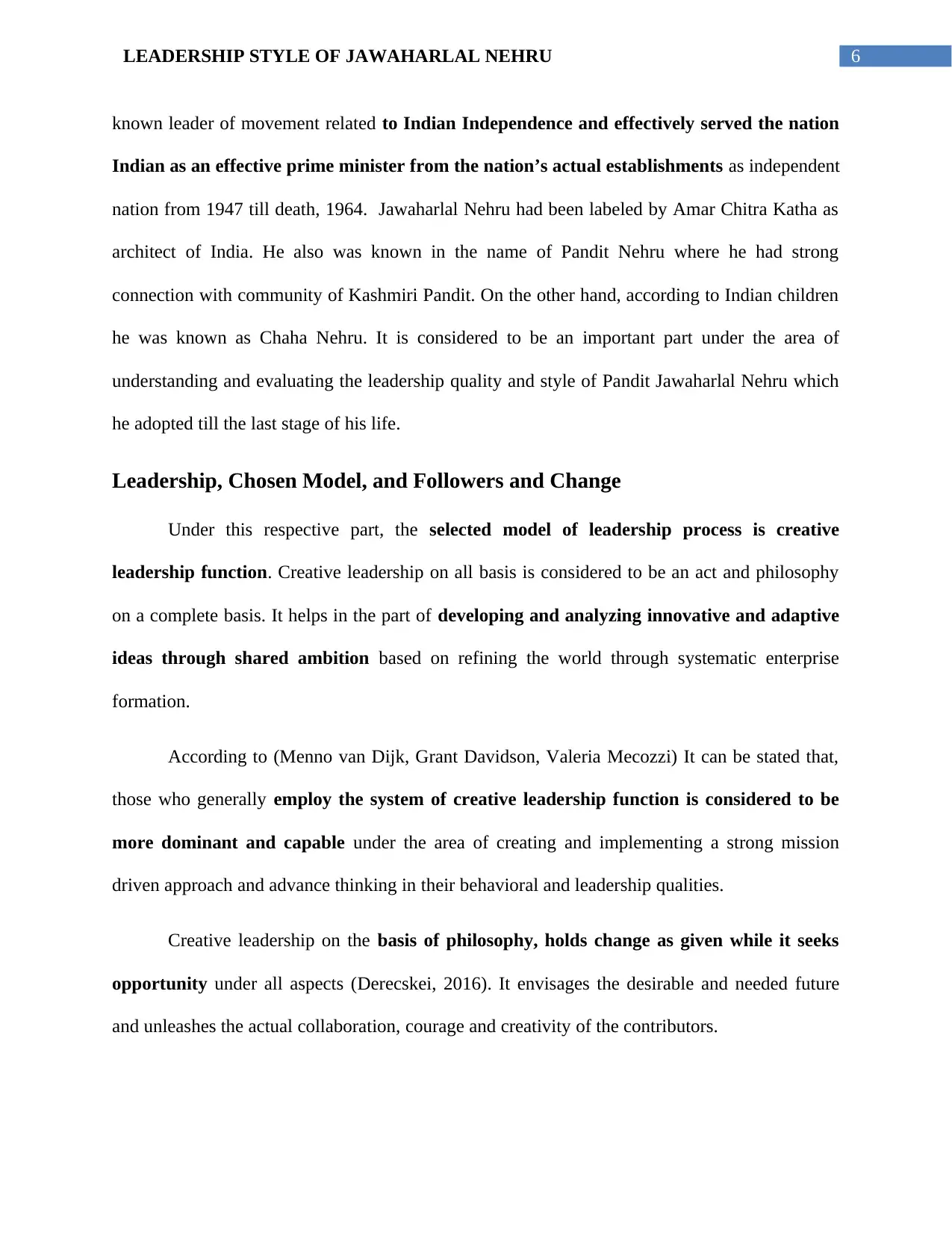
6LEADERSHIP STYLE OF JAWAHARLAL NEHRU
known leader of movement related to Indian Independence and effectively served the nation
Indian as an effective prime minister from the nation’s actual establishments as independent
nation from 1947 till death, 1964. Jawaharlal Nehru had been labeled by Amar Chitra Katha as
architect of India. He also was known in the name of Pandit Nehru where he had strong
connection with community of Kashmiri Pandit. On the other hand, according to Indian children
he was known as Chaha Nehru. It is considered to be an important part under the area of
understanding and evaluating the leadership quality and style of Pandit Jawaharlal Nehru which
he adopted till the last stage of his life.
Leadership, Chosen Model, and Followers and Change
Under this respective part, the selected model of leadership process is creative
leadership function. Creative leadership on all basis is considered to be an act and philosophy
on a complete basis. It helps in the part of developing and analyzing innovative and adaptive
ideas through shared ambition based on refining the world through systematic enterprise
formation.
According to (Menno van Dijk, Grant Davidson, Valeria Mecozzi) It can be stated that,
those who generally employ the system of creative leadership function is considered to be
more dominant and capable under the area of creating and implementing a strong mission
driven approach and advance thinking in their behavioral and leadership qualities.
Creative leadership on the basis of philosophy, holds change as given while it seeks
opportunity under all aspects (Derecskei, 2016). It envisages the desirable and needed future
and unleashes the actual collaboration, courage and creativity of the contributors.
known leader of movement related to Indian Independence and effectively served the nation
Indian as an effective prime minister from the nation’s actual establishments as independent
nation from 1947 till death, 1964. Jawaharlal Nehru had been labeled by Amar Chitra Katha as
architect of India. He also was known in the name of Pandit Nehru where he had strong
connection with community of Kashmiri Pandit. On the other hand, according to Indian children
he was known as Chaha Nehru. It is considered to be an important part under the area of
understanding and evaluating the leadership quality and style of Pandit Jawaharlal Nehru which
he adopted till the last stage of his life.
Leadership, Chosen Model, and Followers and Change
Under this respective part, the selected model of leadership process is creative
leadership function. Creative leadership on all basis is considered to be an act and philosophy
on a complete basis. It helps in the part of developing and analyzing innovative and adaptive
ideas through shared ambition based on refining the world through systematic enterprise
formation.
According to (Menno van Dijk, Grant Davidson, Valeria Mecozzi) It can be stated that,
those who generally employ the system of creative leadership function is considered to be
more dominant and capable under the area of creating and implementing a strong mission
driven approach and advance thinking in their behavioral and leadership qualities.
Creative leadership on the basis of philosophy, holds change as given while it seeks
opportunity under all aspects (Derecskei, 2016). It envisages the desirable and needed future
and unleashes the actual collaboration, courage and creativity of the contributors.
Paraphrase This Document
Need a fresh take? Get an instant paraphrase of this document with our AI Paraphraser
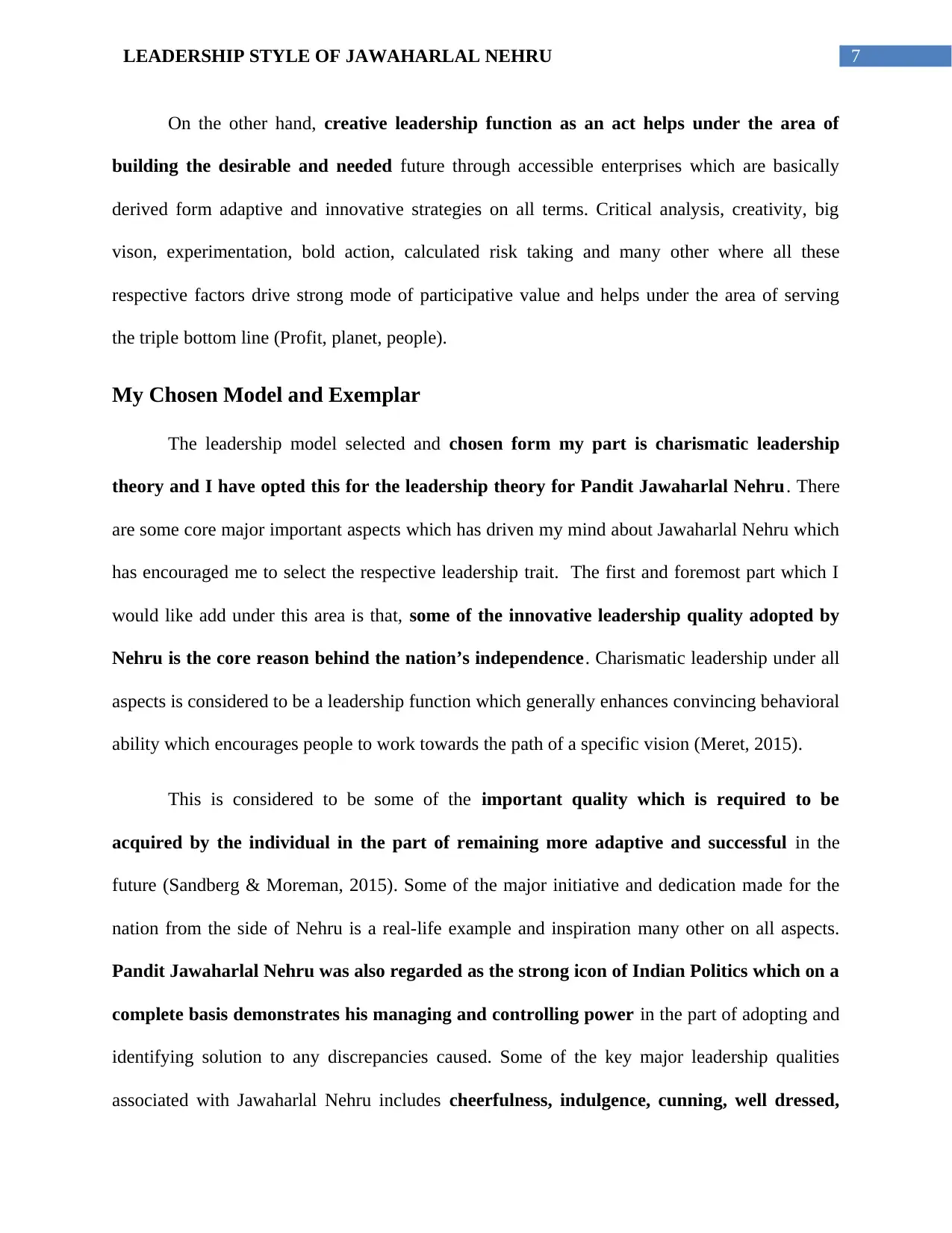
7LEADERSHIP STYLE OF JAWAHARLAL NEHRU
On the other hand, creative leadership function as an act helps under the area of
building the desirable and needed future through accessible enterprises which are basically
derived form adaptive and innovative strategies on all terms. Critical analysis, creativity, big
vison, experimentation, bold action, calculated risk taking and many other where all these
respective factors drive strong mode of participative value and helps under the area of serving
the triple bottom line (Profit, planet, people).
My Chosen Model and Exemplar
The leadership model selected and chosen form my part is charismatic leadership
theory and I have opted this for the leadership theory for Pandit Jawaharlal Nehru. There
are some core major important aspects which has driven my mind about Jawaharlal Nehru which
has encouraged me to select the respective leadership trait. The first and foremost part which I
would like add under this area is that, some of the innovative leadership quality adopted by
Nehru is the core reason behind the nation’s independence. Charismatic leadership under all
aspects is considered to be a leadership function which generally enhances convincing behavioral
ability which encourages people to work towards the path of a specific vision (Meret, 2015).
This is considered to be some of the important quality which is required to be
acquired by the individual in the part of remaining more adaptive and successful in the
future (Sandberg & Moreman, 2015). Some of the major initiative and dedication made for the
nation from the side of Nehru is a real-life example and inspiration many other on all aspects.
Pandit Jawaharlal Nehru was also regarded as the strong icon of Indian Politics which on a
complete basis demonstrates his managing and controlling power in the part of adopting and
identifying solution to any discrepancies caused. Some of the key major leadership qualities
associated with Jawaharlal Nehru includes cheerfulness, indulgence, cunning, well dressed,
On the other hand, creative leadership function as an act helps under the area of
building the desirable and needed future through accessible enterprises which are basically
derived form adaptive and innovative strategies on all terms. Critical analysis, creativity, big
vison, experimentation, bold action, calculated risk taking and many other where all these
respective factors drive strong mode of participative value and helps under the area of serving
the triple bottom line (Profit, planet, people).
My Chosen Model and Exemplar
The leadership model selected and chosen form my part is charismatic leadership
theory and I have opted this for the leadership theory for Pandit Jawaharlal Nehru. There
are some core major important aspects which has driven my mind about Jawaharlal Nehru which
has encouraged me to select the respective leadership trait. The first and foremost part which I
would like add under this area is that, some of the innovative leadership quality adopted by
Nehru is the core reason behind the nation’s independence. Charismatic leadership under all
aspects is considered to be a leadership function which generally enhances convincing behavioral
ability which encourages people to work towards the path of a specific vision (Meret, 2015).
This is considered to be some of the important quality which is required to be
acquired by the individual in the part of remaining more adaptive and successful in the
future (Sandberg & Moreman, 2015). Some of the major initiative and dedication made for the
nation from the side of Nehru is a real-life example and inspiration many other on all aspects.
Pandit Jawaharlal Nehru was also regarded as the strong icon of Indian Politics which on a
complete basis demonstrates his managing and controlling power in the part of adopting and
identifying solution to any discrepancies caused. Some of the key major leadership qualities
associated with Jawaharlal Nehru includes cheerfulness, indulgence, cunning, well dressed,
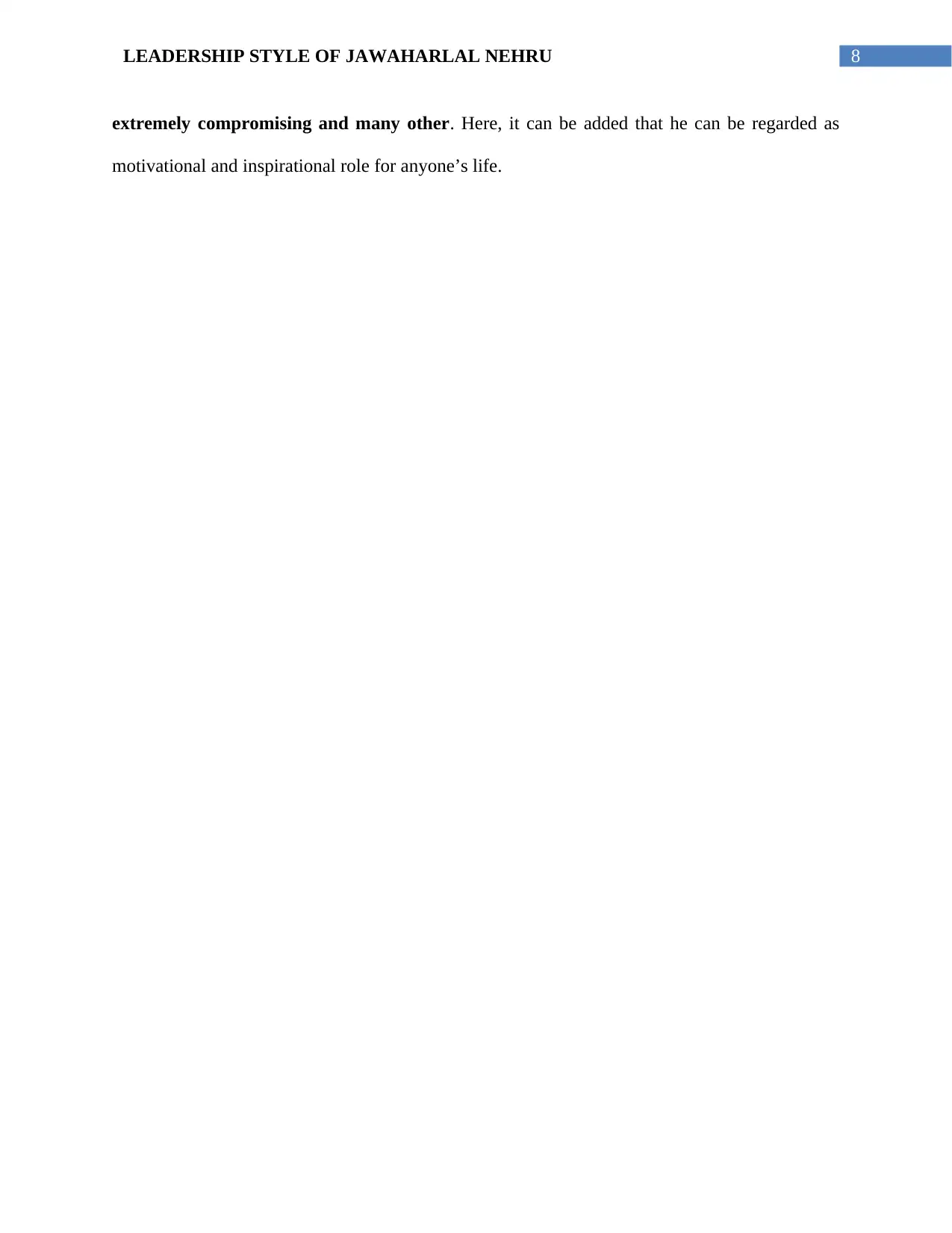
8LEADERSHIP STYLE OF JAWAHARLAL NEHRU
extremely compromising and many other. Here, it can be added that he can be regarded as
motivational and inspirational role for anyone’s life.
extremely compromising and many other. Here, it can be added that he can be regarded as
motivational and inspirational role for anyone’s life.
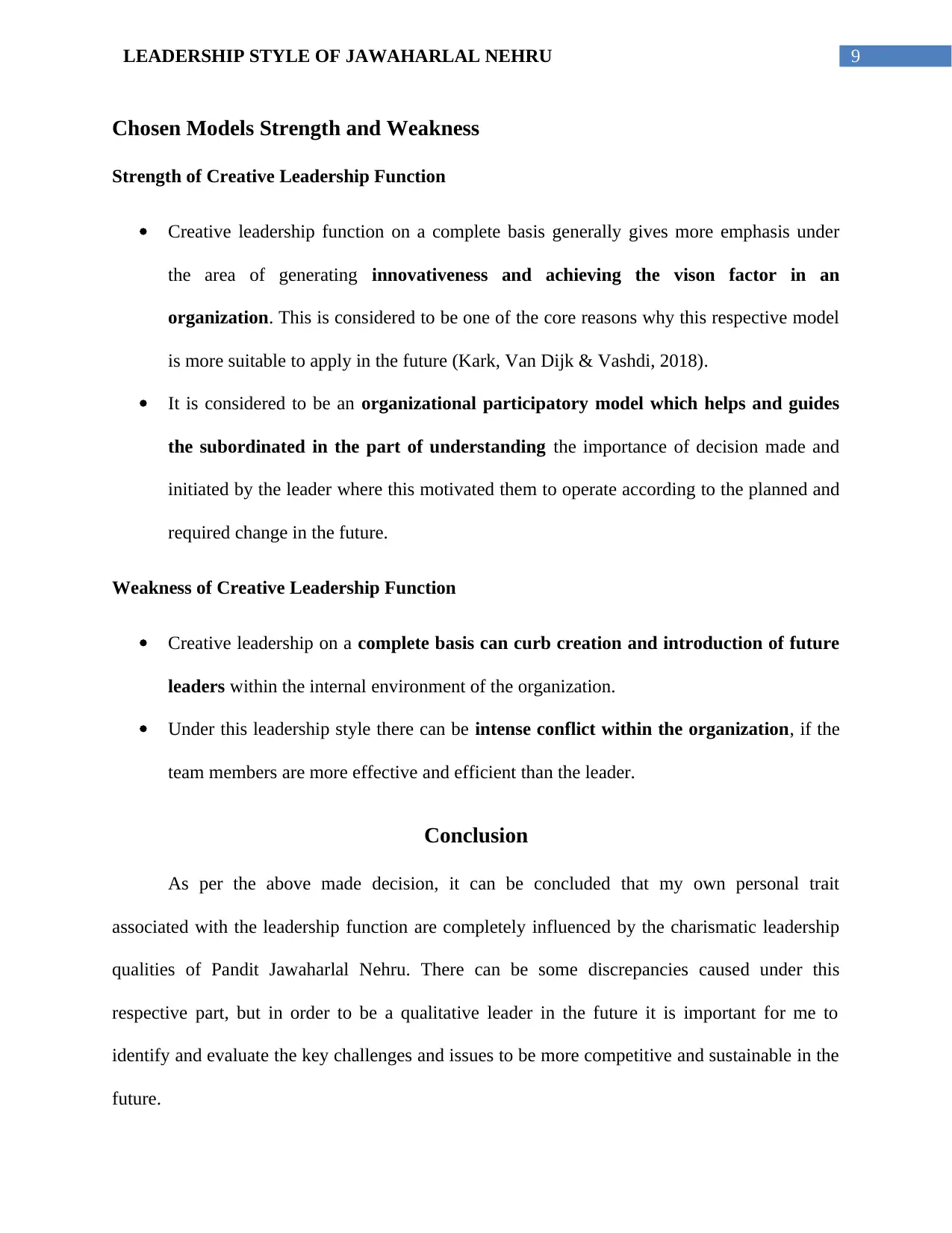
9LEADERSHIP STYLE OF JAWAHARLAL NEHRU
Chosen Models Strength and Weakness
Strength of Creative Leadership Function
Creative leadership function on a complete basis generally gives more emphasis under
the area of generating innovativeness and achieving the vison factor in an
organization. This is considered to be one of the core reasons why this respective model
is more suitable to apply in the future (Kark, Van Dijk & Vashdi, 2018).
It is considered to be an organizational participatory model which helps and guides
the subordinated in the part of understanding the importance of decision made and
initiated by the leader where this motivated them to operate according to the planned and
required change in the future.
Weakness of Creative Leadership Function
Creative leadership on a complete basis can curb creation and introduction of future
leaders within the internal environment of the organization.
Under this leadership style there can be intense conflict within the organization, if the
team members are more effective and efficient than the leader.
Conclusion
As per the above made decision, it can be concluded that my own personal trait
associated with the leadership function are completely influenced by the charismatic leadership
qualities of Pandit Jawaharlal Nehru. There can be some discrepancies caused under this
respective part, but in order to be a qualitative leader in the future it is important for me to
identify and evaluate the key challenges and issues to be more competitive and sustainable in the
future.
Chosen Models Strength and Weakness
Strength of Creative Leadership Function
Creative leadership function on a complete basis generally gives more emphasis under
the area of generating innovativeness and achieving the vison factor in an
organization. This is considered to be one of the core reasons why this respective model
is more suitable to apply in the future (Kark, Van Dijk & Vashdi, 2018).
It is considered to be an organizational participatory model which helps and guides
the subordinated in the part of understanding the importance of decision made and
initiated by the leader where this motivated them to operate according to the planned and
required change in the future.
Weakness of Creative Leadership Function
Creative leadership on a complete basis can curb creation and introduction of future
leaders within the internal environment of the organization.
Under this leadership style there can be intense conflict within the organization, if the
team members are more effective and efficient than the leader.
Conclusion
As per the above made decision, it can be concluded that my own personal trait
associated with the leadership function are completely influenced by the charismatic leadership
qualities of Pandit Jawaharlal Nehru. There can be some discrepancies caused under this
respective part, but in order to be a qualitative leader in the future it is important for me to
identify and evaluate the key challenges and issues to be more competitive and sustainable in the
future.
Secure Best Marks with AI Grader
Need help grading? Try our AI Grader for instant feedback on your assignments.
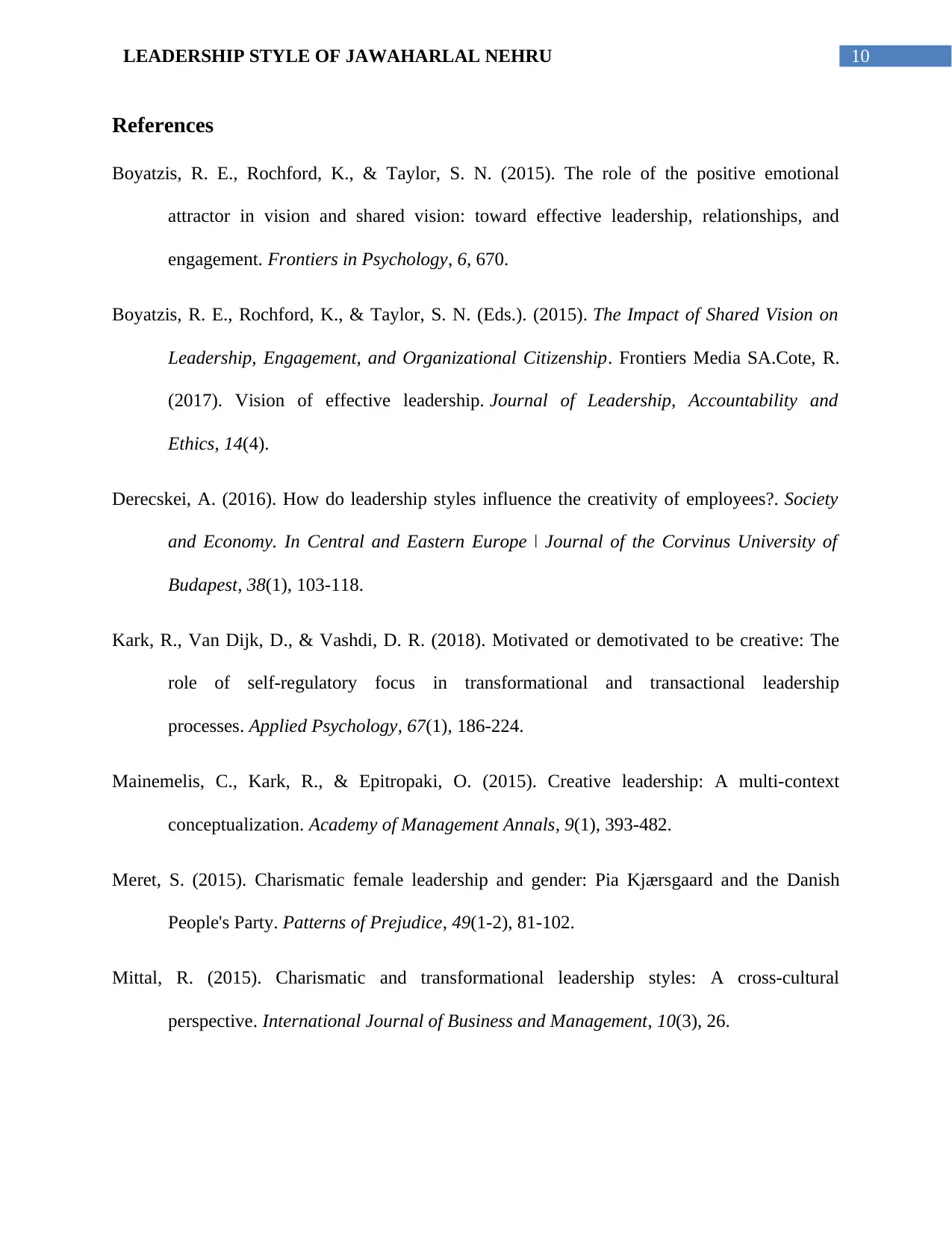
10LEADERSHIP STYLE OF JAWAHARLAL NEHRU
References
Boyatzis, R. E., Rochford, K., & Taylor, S. N. (2015). The role of the positive emotional
attractor in vision and shared vision: toward effective leadership, relationships, and
engagement. Frontiers in Psychology, 6, 670.
Boyatzis, R. E., Rochford, K., & Taylor, S. N. (Eds.). (2015). The Impact of Shared Vision on
Leadership, Engagement, and Organizational Citizenship. Frontiers Media SA.Cote, R.
(2017). Vision of effective leadership. Journal of Leadership, Accountability and
Ethics, 14(4).
Derecskei, A. (2016). How do leadership styles influence the creativity of employees?. Society
and Economy. In Central and Eastern Europe ǀ Journal of the Corvinus University of
Budapest, 38(1), 103-118.
Kark, R., Van Dijk, D., & Vashdi, D. R. (2018). Motivated or demotivated to be creative: The
role of self‐regulatory focus in transformational and transactional leadership
processes. Applied Psychology, 67(1), 186-224.
Mainemelis, C., Kark, R., & Epitropaki, O. (2015). Creative leadership: A multi-context
conceptualization. Academy of Management Annals, 9(1), 393-482.
Meret, S. (2015). Charismatic female leadership and gender: Pia Kjærsgaard and the Danish
People's Party. Patterns of Prejudice, 49(1-2), 81-102.
Mittal, R. (2015). Charismatic and transformational leadership styles: A cross-cultural
perspective. International Journal of Business and Management, 10(3), 26.
References
Boyatzis, R. E., Rochford, K., & Taylor, S. N. (2015). The role of the positive emotional
attractor in vision and shared vision: toward effective leadership, relationships, and
engagement. Frontiers in Psychology, 6, 670.
Boyatzis, R. E., Rochford, K., & Taylor, S. N. (Eds.). (2015). The Impact of Shared Vision on
Leadership, Engagement, and Organizational Citizenship. Frontiers Media SA.Cote, R.
(2017). Vision of effective leadership. Journal of Leadership, Accountability and
Ethics, 14(4).
Derecskei, A. (2016). How do leadership styles influence the creativity of employees?. Society
and Economy. In Central and Eastern Europe ǀ Journal of the Corvinus University of
Budapest, 38(1), 103-118.
Kark, R., Van Dijk, D., & Vashdi, D. R. (2018). Motivated or demotivated to be creative: The
role of self‐regulatory focus in transformational and transactional leadership
processes. Applied Psychology, 67(1), 186-224.
Mainemelis, C., Kark, R., & Epitropaki, O. (2015). Creative leadership: A multi-context
conceptualization. Academy of Management Annals, 9(1), 393-482.
Meret, S. (2015). Charismatic female leadership and gender: Pia Kjærsgaard and the Danish
People's Party. Patterns of Prejudice, 49(1-2), 81-102.
Mittal, R. (2015). Charismatic and transformational leadership styles: A cross-cultural
perspective. International Journal of Business and Management, 10(3), 26.
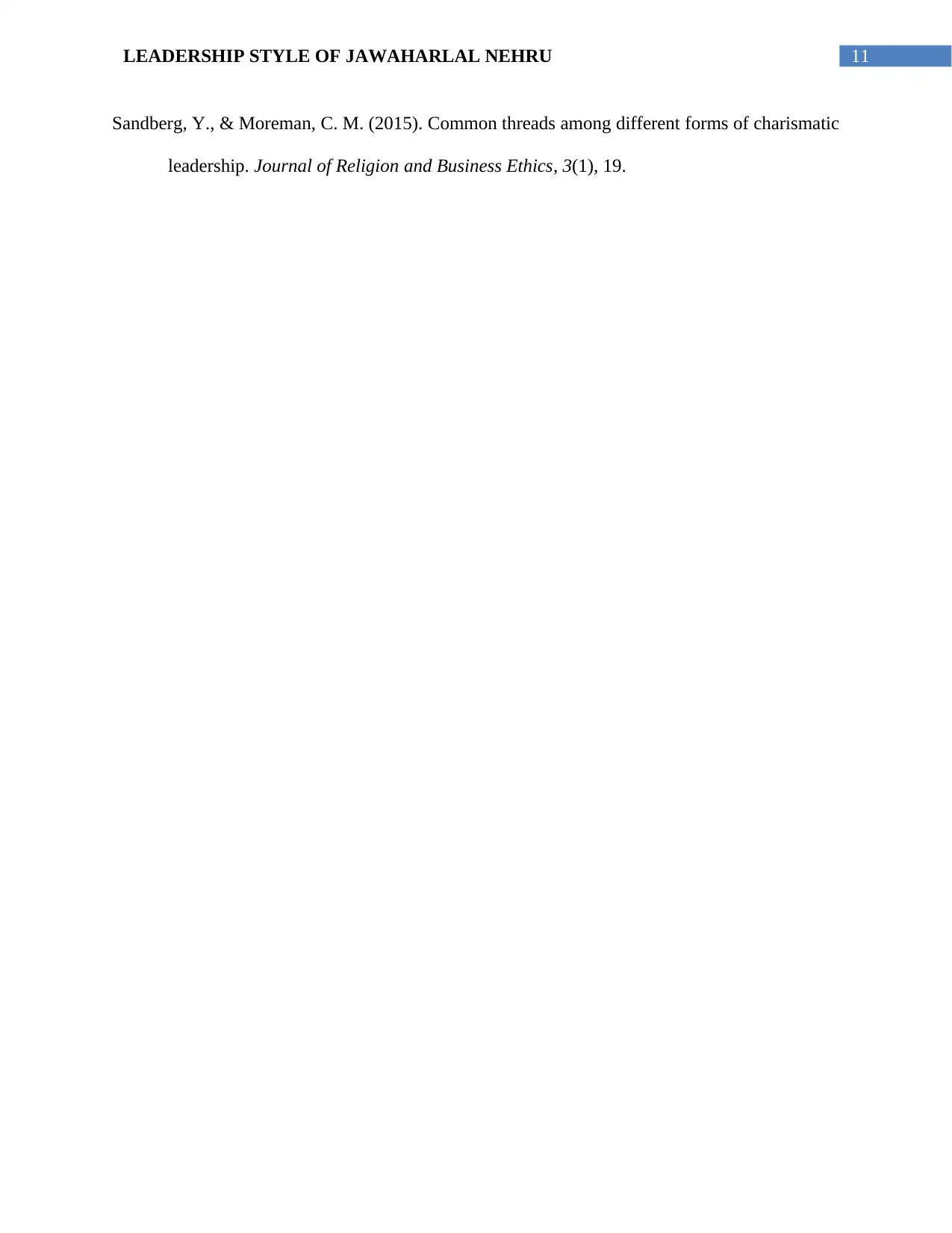
11LEADERSHIP STYLE OF JAWAHARLAL NEHRU
Sandberg, Y., & Moreman, C. M. (2015). Common threads among different forms of charismatic
leadership. Journal of Religion and Business Ethics, 3(1), 19.
Sandberg, Y., & Moreman, C. M. (2015). Common threads among different forms of charismatic
leadership. Journal of Religion and Business Ethics, 3(1), 19.
1 out of 12
Related Documents
Your All-in-One AI-Powered Toolkit for Academic Success.
+13062052269
info@desklib.com
Available 24*7 on WhatsApp / Email
![[object Object]](/_next/static/media/star-bottom.7253800d.svg)
Unlock your academic potential
© 2024 | Zucol Services PVT LTD | All rights reserved.





